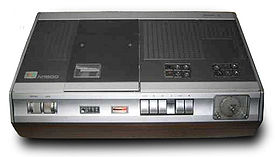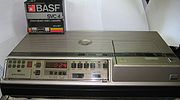
Video Cassette Recording
Encyclopedia

Analog recording
Analog recording is a technique used for the recording of analog signals which among many possibilities include audio frequency, analog audio and analog video information for later playback.Analog recording methods store signals as a continual wave in or on the media...
format designed by Philips
Philips
Koninklijke Philips Electronics N.V. , more commonly known as Philips, is a multinational Dutch electronics company....
. It was the first successful consumer-level home videocassette recorder
Videocassette recorder
The videocassette recorder , is a type of electro-mechanical device that uses removable videocassettes that contain magnetic tape for recording analog audio and analog video from broadcast television so that the images and sound can be played back at a more convenient time...
(VCR) system. Later variants included the VCR-LP and Super Video (SVR) formats.
The VCR format was introduced in 1972, just after the Sony
Sony
, commonly referred to as Sony, is a Japanese multinational conglomerate corporation headquartered in Minato, Tokyo, Japan and the world's fifth largest media conglomerate measured by revenues....
U-matic
U-matic
U-matic is an analog recording videocassette format first shown by Sony in prototype in October 1969, and introduced to the market in September 1971. It was among the first video formats to contain the videotape inside a cassette, as opposed to the various Reel-to-Reel or open-reel formats of the...
format in 1971. Although at first glance the two might appear to have been competing formats, they were aimed at very different markets. U-matic was introduced as a professional television production format, whilst VCR was targeted particularly at educational but also domestic users. Unlike some other early formats such as Cartrivision
Cartrivision
Cartrivision was an analog video videocassette format introduced in 1972, and the first format to offer feature films for consumer rental. It was produced by Frank Stanton's Cartridge Television, Inc. , a subsidiary of Avco, who also owned Embassy Pictures at the time. Cartrivision was available in...
, the VCR format does record a high-quality video signal without resorting to Skip field
Skip field
In video, skip field recording is a process in which only one field of video is recorded in order to conserve recording media space. For some kinds of recording, the quality loss of not using both fields of video is fairly negligible, it results in the loss of half of possible vertical video...
.
Home video systems had previously been available, but they were open-reel systems (most notably made by Sony) and were expensive to both buy and operate. They were also unreliable and often only recorded in black and white such as the EIAJ-1
EIAJ-1
EIAJ-1, developed by the Electronic Industries Association of Japan in 1969, was the first standardized format for industrial/non-broadcast videotape recorders...
. The VCR system was easy to use and recorded in colour but was still expensive: the N1500 recorder cost nearly £600
Pound sterling
The pound sterling , commonly called the pound, is the official currency of the United Kingdom, its Crown Dependencies and the British Overseas Territories of South Georgia and the South Sandwich Islands, British Antarctic Territory and Tristan da Cunha. It is subdivided into 100 pence...
in the United Kingdom
United Kingdom
The United Kingdom of Great Britain and Northern IrelandIn the United Kingdom and Dependencies, other languages have been officially recognised as legitimate autochthonous languages under the European Charter for Regional or Minority Languages...
when it was introduced in 1972, the equivalent of just over £6000 in 2009. By comparison a small car (the Morris Mini
Mini
The Mini is a small car that was made by the British Motor Corporation and its successors from 1959 until 2000. The original is considered a British icon of the 1960s, and its space-saving front-wheel-drive layout influenced a generation of car-makers...
) could be purchased for just over £600.

Magnetic tape
Magnetic tape is a medium for magnetic recording, made of a thin magnetizable coating on a long, narrow strip of plastic. It was developed in Germany, based on magnetic wire recording. Devices that record and play back audio and video using magnetic tape are tape recorders and video tape recorders...
. Three playing times were available: 30, 45 and 60 minutes. The 60-minute videocassettes proved very unreliable, suffering numerous snags and breakages due to the very thin video tape. The mechanically complicated recorders themselves also proved somewhat unreliable. One particularly common failing occurred should tape slack develop within the cassette; the tape from the top (takeup) spool may droop into the path of the bottom (supply) spool and become entangled in it if rewind was selected. The cassette would then completely jam and require dismantling to clear the problem, and the tape would then be creased and damaged.
The system predated the development of the slant azimuth technique to prevent crosstalk between adjacent video tracks, so it had to use an unrecorded guard band
Guard band
-Radio and electronic signalling:In radio, a guard band is an unused part of the radio spectrum between radio bands, for the purpose of preventing interference....
between tracks. This required the system to run at a high tape speed of 11.26 inches per second.
Despite its limitations, the Philips VCR system was groundbreaking and brought together many advances in video recording technology to produce the first truly practical home video cassette system. The very first Philips N1500 model included all the essential elements of a domestic video cassette recorder:
- Simple loading of cassette and simple operation by "Piano Key" controls, with full auto-stop at tape ends.
- A tuner for recording off-air television programmes.
- A clock with timer for unattended recordings.
- A modulator to allow connection to a normal (for the time) television receiver without audio and video input connectors.
The Philips VCR system was only marketed in the U.K. and Europe. In mid-1977, Philips announced they were considering distribution of the format in North America, and it was test marketed for several months. Because the format was initially designed only for use with the 625-line 50 Hz PAL
PAL
PAL, short for Phase Alternating Line, is an analogue television colour encoding system used in broadcast television systems in many countries. Other common analogue television systems are NTSC and SECAM. This page primarily discusses the PAL colour encoding system...
system, VCR units had to be modified in order to work with the 60 Hz NTSC
NTSC
NTSC, named for the National Television System Committee, is the analog television system that is used in most of North America, most of South America , Burma, South Korea, Taiwan, Japan, the Philippines, and some Pacific island nations and territories .Most countries using the NTSC standard, as...
system. Unfortunately, for mechanical and electronic reasons, the tape speed had to be increased by 20%, which resulted in a 60-minute PAL tape running for 50 minutes in a NTSC machine. DuPont announced a thinner videotape formulation that would allow a 60-minute NTSC VCR tape (and roughly 70 minutes in PAL), but the tape was even less reliable than previous formulations. Ultimately, Philips abandoned any hope of trying to sell their VCR format in North America, partly because of the reliability issues, and partly because of the introduction of VHS that same year.
Variants

A later even longer-playing variant, Super Video (SVR) was manufactured by Grundig
Grundig
Grundig AG is a German manufacturer of consumer electronics for home entertainment which transferred to Turkish control in 2004-2007. Established in 1945 in Nuremberg by Max Grundig, the company changed hands several times before becoming part of the Turkish Koç Holding group...
exclusively. SVR was designed to exclusively use BASF
BASF
BASF SE is the largest chemical company in the world and is headquartered in Germany. BASF originally stood for Badische Anilin- und Soda-Fabrik . Today, the four letters are a registered trademark and the company is listed on the Frankfurt Stock Exchange, London Stock Exchange, and Zurich Stock...
and Agfa
Agfa-Gevaert
Agfa-Gevaert N.V. is a European multinational corporation that develops, manufactures, and distributes analogue and digital imaging products and systems, as well as IT solutions. The company has three divisions. Agfa Graphics offers integrated prepress and industrial inkjet systems to the...
-manufactured chrome-dioxide tape in cassettes that were identical to the earlier Philips ones, with the exception of a small actuator added to the bottom of the cassette. This meant that only the BASF/Agfa tapes would work in SVR machines, but that such tapes could also be used in the older VCR and VCR-LP machines. Just as VCR-LP recordings are incompatible with VCR, so SVR recordings are incompatible with both VCR and VCR-LP. The only model to be built was the Grundig SVR4004, with a few detail variations such as optional audio/video connectors, plus a rebadged ITT 240.
Model Numbers
The First Philips machine was model number N1500, after which the format is also known. This had "first generation" mechanics including magnetic braking servo systems applied to relatively large mains voltage induction motors. The later model N1502 had a totally different mechanism using DC motors and more advanced electronics, and was somewhat more reliable. A later version again was still called N1502 but had further significant mechanical and electronic advances, and in particular had a worm drive for operation of the loading mechanism rather than a fragile plastic gearbox assembly. The N1512 model offered composite video input and output connectors, but was otherwise the same as the N1502. The VCR-LP model N1700 was closely related to the later N1502 variant. Other, rarer Philips models included stereo sound and editing capabilities.Grundig built a VCR4000 VCR-LP model which had microprocessor control and so treated the tapes more gently than the purely mechanical decks, and the SVR4004 (SVR format) model was very similar. Other Grundig models included the VCR3000 (believed to be VCR format) and VCR5000AV (believed to be dual format VCR and VCR-LP).
Replacement
In the late 1970s, the VCR formats were superseded altogether by Video 2000Video 2000
Video 2000 was a consumer videocassette recorder system and analog recording videocassette standard developed by Philips and Grundig to compete with JVC's VHS and Sony's Betamax video technologies...
(also known as 'Video Compact Cassette' or VCC). Due to the similar initialisms
Acronym and initialism
Acronyms and initialisms are abbreviations formed from the initial components in a phrase or a word. These components may be individual letters or parts of words . There is no universal agreement on the precise definition of the various terms , nor on written usage...
, and the fact that both were designed by Philips, the 'VCC' and 'VCR' formats are often confused. However, the two systems are incompatible, and there are significant differences between them. Some Video 2000 machines carry a modified version of the "VCR" logo, as N1500 and N1700 machines, adding further to this confusion.

